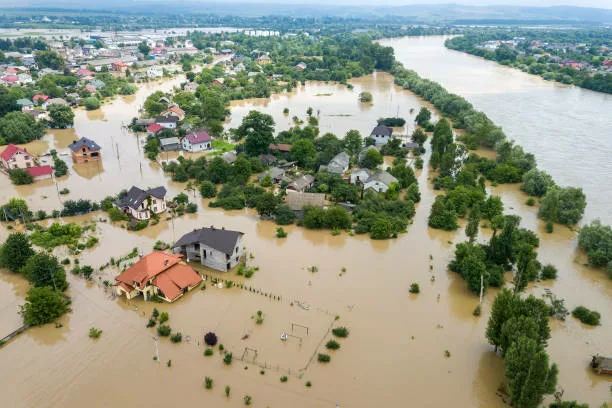Nigeria, like many other countries, is grappling with the relentless impact of climate change, particularly in the form of devastating floods. The latest statistics reveal alarming consequences, including economic losses, loss of lives, and food security threats, all of which underscore the urgency of addressing the nation’s vulnerability to climate-related disasters.
Vice President Kashim Shettima, disclosed that the flood damage incurred by Nigeria in 2022 amounted to a staggering $7billion. This announcement came during a UN Framework Convention on Climate Change event, where Shettima highlighted the severe repercussions of climate change on the nation. He noted that the 2022 flood event led to the tragic loss of 600 lives, further emphasising the human toll of climate change.
The flood-induced damages have had a profound impact on Nigeria’s economy, pushing it further into vulnerability. The floods not only result in immediate losses but also exacerbate food insecurity and disrupt economic activities. The recent heavy rainfall and flooding have only heightened these concerns.
Lagos, Nigeria’s economic hub, is no exception to the flood crisis. According to British Deputy High Commissioner Ben Lewellyn-Jones, Lagos loses approximately $3.9 billion annually due to flooding. He attributed this recurring problem to climate change, inadequate drainage systems, and poorly constructed buildings. Lewellyn-Jones emphasised that climate change is manifesting in erratic and extreme rainfall patterns, amplifying the flood challenge. Moreover, blocked drainages and plastic waste contribute to the flooding, affecting both rich and poor residents alike.
While Lagos faces unique challenges, the issue of waste management is a common concern both in Nigeria and globally. Lewellyn-Jones suggested practical measures like establishing more recycling points and introducing financial incentives to encourage recycling.
However, the devastating effects of floods extend well beyond economic losses. More than 2.5 million Nigerians urgently require humanitarian assistance, with children comprising 60 per cent of this vulnerable population. The severe flooding, the worst in a decade, has displaced 1.3 million people and claimed over 600 lives. Cases of waterborne diseases, respiratory infections, and skin diseases have surged. Cholera outbreaks in specific regions have added to the humanitarian crisis.
Nigeria’s vulnerability to climate change and extreme weather events is underscored by its high ranking on UNICEF’s Children’s Climate Risk Index (CCRI). The country is considered at ‘extremely high risk’ for climate change impacts, a status that places children at grave risk due to inadequate essential services such as water, sanitation, healthcare, and education.
While climate change undoubtedly contributes to flooding, the release of water from the Lagdo Dam in neighboring Cameroon significantly exacerbated the 2022 floods. This highlighted the importance of cross-border cooperation and effective dam management in mitigating climate-related disasters.
There can be no gainsaying the fact that building resilience in communities is an essential strategy to combat floods and other disasters within Nigeria. However, despite the clear importance of this approach, the Nigerian government has often fallen short in implementing robust measures to mitigate the devastating impact of floods. This negligence is particularly concerning given the increasing frequency and severity of floods, which have dire consequences for the nation.
Director-general of the National Emergency Management Agency (NEMA), Mustapha Ahmed Habib, recently emphasised the importance of resilience-building during a media parley in Lagos. He stressed that resilience aligns with global standards on disaster risk reduction. Resilience, in this context, refers to a community’s ability to withstand and recover from natural disasters and crises, ultimately reducing their impact.
Reacting, an environmentalist, Samuel Akpan, noted that one fundamental way to build resilience is through investment in flood-resistant infrastructure, including flood barriers, reinforced buildings, and drainage systems. He said these investments, while costly, can save lives and prevent long-term damage. “However, such initiatives have been sporadic, leaving many communities vulnerable.
“Another critical aspect of resilience-building is community education on disaster preparedness. This includes teaching people safe evacuation procedures, the importance of stockpiling emergency supplies, and effective communication during a crisis. Sadly, these vital educational efforts remain inadequate and disjointed,” he stated.
Another environmentalist, Dr. Jude Atama, told NATIONAL ECONOMY that community involvement is another neglected element of resilience-building. He stated that when communities actively participate in disaster preparation, they are more likely to succeed. Organising community meetings, establishing emergency response teams, and creating communication networks are vital components of this strategy. However, he cautioned that limited government engagement with communities and a lack of resources hinder progress in this area.
Atama added that local authorities are pivotal in flood prevention, mitigation, and management, yet their potential remains untapped. “They play a central role in identifying flood-prone areas through mapping and modeling, predicting flood patterns, and assessing potential impacts on communities. However, these activities are often conducted sporadically, leaving many areas unprepared.
“Moreover, local authorities are responsible for implementing flood mitigation measures such as flood barriers and improved drainage systems. Regulatory efforts to control development in flood-prone areas should also be part of their responsibilities. Unfortunately, regulatory frameworks are lax, and flood-prone areas continue to witness unregulated construction,” he said.
Akpan, earlier quoted, said, “Local authorities must coordinate emergency response plans, including evacuation procedures and shelter provisions. They should ensure that essential services like hospitals and utilities remain operational during floods. Public education about flood risks and preparedness, including information on evacuation routes and flood insurance, is also their responsibility. However, these educational efforts often fall short.
“Post-flood recovery efforts are equally critical, requiring the collaboration of local authorities with federal and state agencies. Damage assessments, support to affected residents, and coordination with government and non-governmental organisations are pivotal tasks in this phase. Nevertheless, the coordination of recovery efforts remains suboptimal,” he said.
A lecturer at Ebonyi State University, Dr. Nelson Nkwo, stated that ecological funds, meant to address disaster-related situations, are not always efficiently applied by local governments. He said this misallocation of resources exacerbates the problem and leaves communities ill-prepared to cope with floods.
He further said addressing the root causes of natural disasters, particularly climate change, is vital. “By reducing greenhouse gas emissions and investing in renewable energy, Nigeria can mitigate the impact of climate change and reduce the risk of disasters. However, comprehensive strategies to address climate change are often missing from government agendas,” he said.
On his part, Peter Ezeibe, a social affairs analyst, said Nigeria’s neglect of flood mitigation measures reflects a missed opportunity to protect its citizens from recurring disasters. He noted that despite ample guidance on building resilience, the government has struggled to implement these strategies effectively. “To reduce the impact of floods and better prepare communities, the Nigerian government must prioritise and invest in comprehensive flood prevention and mitigation measures,” he said.
It is noteworthy that the persistent annual trend of flood disasters has the propensity to worsen the rising trend of food insecurity in the country.
The usual nationwide flood disaster period, September to November, as was the case in 2022, usually precedes the time just before harvest season. It regularly destroys millions of hectares of crops.
For example, Olam rice farm in Doma LGA of Niger State came to light to have lost about 4000 hectares of land and a few other properties to flooding in October 2022.
Described as one of the biggest rice farms in the whole of West Africa, the farm produces thousands of tons of rice annually and employs more than 1000 persons from the neighbouring villages, making it an asset for the host communities.
The farm has an integrated rice mill with a processing capacity of 70,000 tonnes, thus, reducing Nigeria’s rice imports. Nigeria has for years been a net importer of rice, a major staple food item it is capable of producing.





